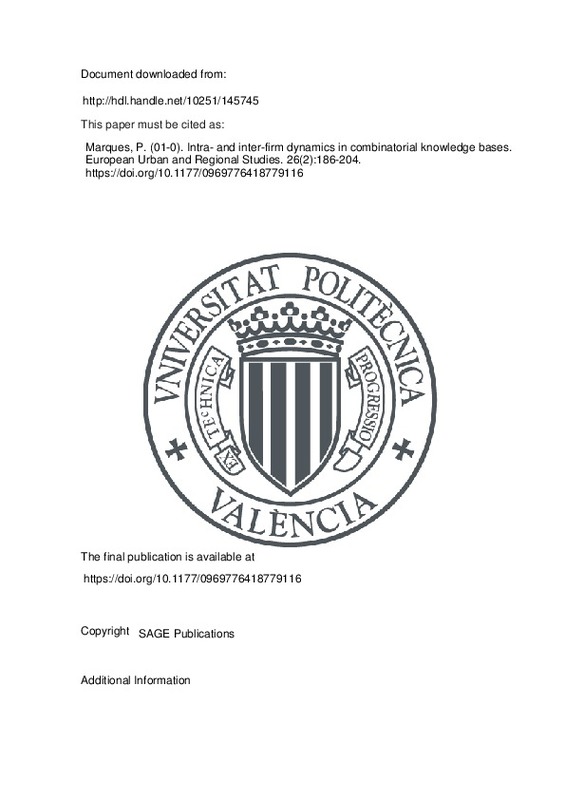Asheim, B. T., Boschma, R., & Cooke, P. (2011). Constructing Regional Advantage: Platform Policies Based on Related Variety and Differentiated Knowledge Bases. Regional Studies, 45(7), 893-904. doi:10.1080/00343404.2010.543126
Balland, P.-A., & Rigby, D. (2016). The Geography of Complex Knowledge. Economic Geography, 93(1), 1-23. doi:10.1080/00130095.2016.1205947
Christopherson, S., & Clark, J. (2007). Power in Firm Networks: What it Means for Regional Innovation Systems. Regional Studies, 41(9), 1223-1236. doi:10.1080/00343400701543330
[+]
Asheim, B. T., Boschma, R., & Cooke, P. (2011). Constructing Regional Advantage: Platform Policies Based on Related Variety and Differentiated Knowledge Bases. Regional Studies, 45(7), 893-904. doi:10.1080/00343404.2010.543126
Balland, P.-A., & Rigby, D. (2016). The Geography of Complex Knowledge. Economic Geography, 93(1), 1-23. doi:10.1080/00130095.2016.1205947
Christopherson, S., & Clark, J. (2007). Power in Firm Networks: What it Means for Regional Innovation Systems. Regional Studies, 41(9), 1223-1236. doi:10.1080/00343400701543330
Cusmano, L., Morrison, A., & Rabellotti, R. (2010). Catching up Trajectories in the Wine Sector: A Comparative Study of Chile, Italy, and South Africa. World Development, 38(11), 1588-1602. doi:10.1016/j.worlddev.2010.05.002
Dosi, G., Faillo, M., & Marengo, L. (2008). Organizational Capabilities, Patterns of Knowledge Accumulation and Governance Structures in Business Firms: An Introduction. Organization Studies, 29(8-9), 1165-1185. doi:10.1177/0170840608094775
Giuliani, E. (2007). The selective nature of knowledge networks in clusters: evidence from the wine industry. Journal of Economic Geography, 7(2), 139-168. doi:10.1093/jeg/lbl014
Giuliani, E., & Bell, M. (2005). The micro-determinants of meso-level learning and innovation: evidence from a Chilean wine cluster. Research Policy, 34(1), 47-68. doi:10.1016/j.respol.2004.10.008
Giuliani, E., Morrison, A., & Rabellotti, R. (2011). Innovation and Technological Catch-Up. doi:10.4337/9780857930514
Grant, R. M. (1996). Toward a knowledge-based theory of the firm. Strategic Management Journal, 17(S2), 109-122. doi:10.1002/smj.4250171110
Halkier, H., James, L., Dahlström, M., & Manniche, J. (2012). Knowledge Dynamics, Regions and Public Policy. European Planning Studies, 20(11), 1759-1766. doi:10.1080/09654313.2012.723419
Hatch, C. J. (2013). Competitiveness by Design: An Institutionalist Perspective on the Resurgence of a «Mature» Industry in a High-Wage Economy. Economic Geography, 89(3), 261-284. doi:10.1111/ecge.12009
Helfat, C. E. (2015). Vertical firm structure and industry evolution. Industrial and Corporate Change, 24(4), 803-818. doi:10.1093/icc/dtv027
Malerba, F., Nelson, R., Orsenigo, L., & Winter, S. (2008). Vertical integration and disintegration of computer firms: a history-friendly model of the coevolution of the computer and semiconductor industries. Industrial and Corporate Change, 17(2), 197-231. doi:10.1093/icc/dtn001
Manniche, J. (2012). Combinatorial Knowledge Dynamics: On the Usefulness of the Differentiated Knowledge Bases Model. European Planning Studies, 20(11), 1823-1841. doi:10.1080/09654313.2012.723423
Manniche, J., Moodysson, J., & Testa, S. (2016). Combinatorial Knowledge Bases: An Integrative and Dynamic Approach to Innovation Studies. Economic Geography, 93(5), 480-499. doi:10.1080/00130095.2016.1205948
Marques, P. (2017). From toys to automobiles: foreign investment, firm heterogeneity and intermediaries in a Portuguese industry. European Planning Studies, 25(8), 1375-1393. doi:10.1080/09654313.2017.1303822
Marques, P. (2017). Human capital and university–business interactions: an example from the wine industry. Regional Studies, Regional Science, 4(1), 154-160. doi:10.1080/21681376.2017.1341818
Martin, R., & Moodysson, J. (2011). Comparing knowledge bases: on the geography and organization of knowledge sourcing in the regional innovation system of Scania, Sweden. European Urban and Regional Studies, 20(2), 170-187. doi:10.1177/0969776411427326
Martin, R., & Sunley, P. (2003). Deconstructing clusters: chaotic concept or policy panacea? Journal of Economic Geography, 3(1), 5-35. doi:10.1093/jeg/3.1.5
Moulaert, F., & Sekia, F. (2003). Territorial Innovation Models: A Critical Survey. Regional Studies, 37(3), 289-302. doi:10.1080/0034340032000065442
Pina, K., & Tether, B. S. (2016). Towards understanding variety in knowledge intensive business services by distinguishing their knowledge bases. Research Policy, 45(2), 401-413. doi:10.1016/j.respol.2015.10.005
Polenske, K. R. (Ed.). (2007). The Economic Geography of Innovation. doi:10.1017/cbo9780511493386
Rabellotti, R., & Schmitz, H. (1999). The Internal Heterogeneity of Industrial Districts in Italy, Brazil and Mexico. Regional Studies, 33(2), 97-108. doi:10.1080/00343409950122909
Tödtling, F., & Grillitsch, M. (2015). Does Combinatorial Knowledge Lead to a Better Innovation Performance of Firms? European Planning Studies, 23(9), 1741-1758. doi:10.1080/09654313.2015.1056773
WILLIAMSON, O. E. (1995). Hierarchies, Markets and Power in the Economy : An Economic Perspective. Industrial and Corporate Change, 4(1), 21-49. doi:10.1093/icc/4.1.21
[-]







![[Cerrado]](/themes/UPV/images/candado.png)


